《市场营销学》课程授课教案(双语)Chapter 10 Marketing Channels

Chapter 10 Marketing Channels -Delivering Customer Value 教学目的:通过本章的学习,使学生了解分销渠道决策的过程和内容,掌握企业可能 采用的分销渠道的类型及各自的利弊,掌握主要的分销策略及其选择时的影响因素, 了解企业如何对中间商进行评价和挑选,了解物流的职能,掌握运输方式选择策略和 仓储策略。 教学难点:分销渠道与营销渠道的区别:分销渠道的设计:物流的规划管理。 学时分配: 教学内容: Supply Chains and the Value Delivery Network 1.营销做两个铺货: ·把货铺到消费者面前一一渠道 ●把货铺到消费者脑子里一一品牌 2.Producing a product or service and making it available to buyers requires building relationships not just with customers,but also with key suppliers and resellers in the company's supply chain. 3.Value delivery net work-made up of the company,suppliers,distributors and ultimately customers who"partner"with each other to improve the performance of the entire system. The Nature and Importance of Marketing Channels 。从战略高度看渠道: >集道是企业最重要的无形资产之 √经营商品的目的是为了经营资产(使资产增值),经营资产的目的是为了经营 资本,经营资本的目的是为了更好的经营商品 √人、品牌、渠道是企业最重要的资产 √渠道的资产性表现在一且成为资产就可以进行资本运作 >渠道是企业最重要而且是成本最低廉的融资渠道 Marketing channela set of interdependent organizations that help make a product or service available for use or consumption by the consumer or business
1 Chapter 10 Marketing Channels -Delivering Customer Value 教学目的:通过本章的学习,使学生了解分销渠道决策的过程和内容,掌握企业可能 采用的分销渠道的类型及各自的利弊,掌握主要的分销策略及其选择时的影响因素, 了解企业如何对中间商进行评价和挑选,了解物流的职能,掌握运输方式选择策略和 仓储策略。 教学难点:分销渠道与营销渠道的区别;分销渠道的设计;物流的规划管理。 学时分配: 教学内容: 一、 Supply Chains and the Value Delivery Network 1. 营销做两个铺货: ⚫ 把货铺到消费者面前——渠道 ⚫ 把货铺到消费者脑子里——品牌 2. Producing a product or service and making it available to buyers requires building relationships not just with customers, but also with key suppliers and resellers in the company’s supply chain. 3. Value delivery net work—made up of the company, suppliers, distributors and ultimately customers who “partner” with each other to improve the performance of the entire system. 二、 The Nature and Importance of Marketing Channels ⚫ 从战略高度看渠道: ➢ 渠道是企业最重要的无形资产之一 ✓ 经营商品的目的是为了经营资产(使资产增值),经营资产的目的是为了经营 资本,经营资本的目的是为了更好的经营商品 ✓ 人、品牌、渠道是企业最重要的资产 ✓ 渠道的资产性表现在一旦成为资产就可以进行资本运作 ➢ 渠道是企业最重要而且是成本最低廉的融资渠道 ⚫ Marketing channel—a set of interdependent organizations that help make a product or service available for use or consumption by the consumer or business
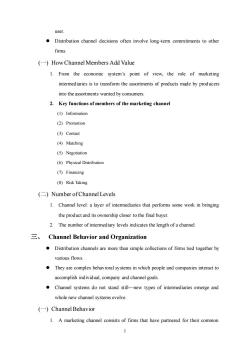
user. Distribution channel decisions often involve long-term commitments to other firms. (-)How Channel Members Add Value 1.From the economic system's point of view,the role of marketing intermediaries is to transform the assortments of products made by producers into the assortments wanted by consumers. 2.Key functions of members of the marketing channel (l))Information (2)Promotion (3)Contact (4)Matching (5)Negotiation (6)Physical Distribution (7)Financing (8)Risk Taking ()Number ofChannel Levels 1.Channel level:a layer of intermediaries that performs some work in bringing the product and its ownership closer to the final buyer 2.The number of intermediary levels indicates the length of a channel. 三、Channel Behavior and Organization Distribution channels are more than simple collections of firms tied together by various flows. They are complex behavioral systems in which people and companies interact to accomplish individual,company and channel goals. Channel systems do not stand still-new types of intermediaries emerge and whole new channel systems evolve. (-)Channel Behavior 1.A marketing channel consists of firms that have partnered for their common 2
2 user. ⚫ Distribution channel decisions often involve long-term commitments to other firms. (一) How Channel Members Add Value 1. From the economic system’s point of view, the role of marketing intermediaries is to transform the assortments of products made by producers into the assortments wanted by consumers. 2. Key functions of members of the marketing channel (1) Information (2) Promotion (3) Contact (4) Matching (5) Negotiation (6) Physical Distribution (7) Financing (8) Risk Taking (二) Number of Channel Levels 1. Channel level: a layer of intermediaries that performs some work in bringing the product and its ownership closer to the final buyer. 2. The number of intermediary levels indicates the length of a channel. 三、 Channel Behavior and Organization ⚫ Distribution channels are more than simple collections of firms tied together by various flows. ⚫ They are complex behavioral systems in which people and companies interact to accomplish individual, company and channel goals. ⚫ Channel systems do not stand still—new types of intermediaries emerge and whole new channel systems evolve. (一) Channel Behavior 1. A marketing channel consists of firms that have partnered for their common
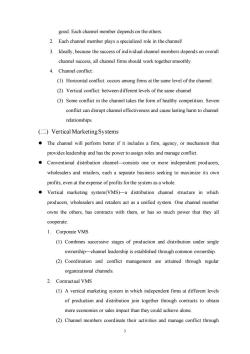
good.Each channel member dependson the others 2.Each channel member plays a specialized role in the channel 3.Ideally,because the success of individual channel members depends on overall channel success,all channel firms should work together smoothly 4.Channel conflict (1)Horizontal conflict:occurs among fimms at the same level ofthe channel. (2)Vertical conflict:between different levels ofthe same channel (3)Some conflict in the channel takes the form of healthy competition.Severe conflict can disrupt channel effectiveness and cause lasting harm to channel relationships. ()Vertical Marketing Systems The channel will perform better if it includes a firm,agency,or mechanism that provides leadership and has the power to assign roles and manage conflict. Conventional distribution channel-consists one or more independent producers. wholesalers and retailers,each a separate business seeking to maximize its own profits,even at the expense of profits for the system as a whole. Vertical marketing system(VMS)a distribution channel structure in which producers,wholesalers and retailers act as a unified system.One channel member owns the others,has contracts with them,or has so much power that they all cooperate. 1.Corporate VMS (1)Combines successive stages of production and distribution under single ownership-channel leadership is established through common ownership. (2)Coordination and conflict management are attained through regular organizational channels. 2.Contractual VMS (1)A vertical marketing system in which independent firms at different levels of production and distribution join together through contracts to obtain more economies or sales impact than they could achieve alone (2)Channel members coordinate their activities and manage conflict through
3 good. Each channel member depends on the others. 2. Each channel member plays a specialized role in the channel/ 3. Ideally, because the success of individual channel members depends on overall channel success, all channel firms should work together smoothly. 4. Channel conflict: (1) Horizontal conflict: occurs among firms at the same level of the channel. (2) Vertical conflict: between different levels of the same channel (3) Some conflict in the channel takes the form of healthy competition. Severe conflict can disrupt channel effectiveness and cause lasting harm to channel relationships. (二) Vertical Marketing Systems ⚫ The channel will perform better if it includes a firm, agency, or mechanism that provides leadership and has the power to assign roles and manage conflict. ⚫ Conventional distribution channel—consists one or more independent producers, wholesalers and retailers, each a separate business seeking to maximize its own profits, even at the expense of profits for the system as a whole. ⚫ Vertical marketing system(VMS)—a distribution channel structure in which producers, wholesalers and retailers act as a unified system. One channel member owns the others, has contracts with them, or has so much power that they all cooperate. 1. Corporate VMS (1) Combines successive stages of production and distribution under single ownership—channel leadership is established through common ownership. (2) Coordination and conflict management are attained through regular organizational channels. 2. Contractual VMS (1) A vertical marketing system in which independent firms at different levels of production and distribution join together through contracts to obtain more economies or sales impact than they could achieve alone. (2) Channel members coordinate their activities and manage conflict through

contractual agreements (3)The franchise organization is the most common type of contractual relationship-a channel member,called a franchisor,links several stages in the production-distribution process 1)Manufacturer-sponsored retailer franchise system 2)Manufacturer-sponsored wholesaler franchise system 3)Service-firm-sponsored retailer franchise system 3.Administered VMS (1)Coordinates successive stages of production and distribution,not through common ownership or contractual ties,but through the size and power of one of the parties. (2)Manufacturers of a top brand can obtain strong trade cooperation and support from resellers. (Horizontal Marketing Systems 1.Two or more companies at one level join together to follow a new marketing opportunity. 2.By working together,companies can combine their financial,production or marketing resources to accomplish more than any one company could alone 3.Companies might join forces with competitors or noncompetitors 4.Such channel arrangements also work well globally. (Multichannel Distribution Systems 1.A single firm sets up two or more marketing channels to reach one or more customer segments 2.Every large company and many small ones distribute through multiple channels 3.Offer many advantages to companies facing large and complex markets. (1)Expand sales and market coverage (2)Gain opportunities to tailor its products and services to the specific needs of diverse customer segments 4.Disadvantages: (1)Harderto control 4
4 contractual agreements. (3) The franchise organization is the most common type of contractual relationship—a channel member, called a franchisor, links several stages in the production-distribution process. 1) Manufacturer-sponsored retailer franchise system 2) Manufacturer-sponsored wholesaler franchise system 3) Service-firm-sponsored retailer franchise system 3. Administered VMS (1) Coordinates successive stages of production and distribution, not through common ownership or contractual ties, but through the size and power of one of the parties. (2) Manufacturers of a top brand can obtain strong trade cooperation and support from resellers. (三) Horizontal Marketing Systems 1. Two or more companies at one level join together to follow a new marketing opportunity. 2. By working together, companies can combine their financial, production or marketing resources to accomplish more than any one company could alone. 3. Companies might join forces with competitors or noncompetitors. 4. Such channel arrangements also work well globally. (四) Multichannel Distribution Systems 1. A single firm sets up two or more marketing channels to reach one or more customer segments. 2. Every large company and many small ones distribute through multiple channels. 3. Offer many advantages to companies facing large and complex markets. (1) Expand sales and market coverage (2) Gain opportunities to tailor its products and services to the specific needs of diverse customer segments 4. Disadvantages: (1) Harder to control
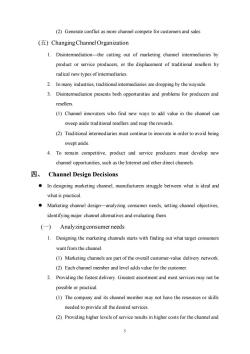
(2)Generate conflict as more channel compete for customers and sales (Changing Channel Organization 1.Disintermediation-the cutting out of marketing channel intermediaries by product or service producers,or the displacement of traditional resellers by radical new types of intermediaries 2.In many industries,traditional intermediaries are dropping by the wayside. 3.Disintermediation presents both opportunities and problems for producers and (1)Channel innovators who find new ways to add value in the channel can sweep aside traditional resellers and reap the rewards. (2)Traditional intermediaries must continue to innovate in order to avoid being swept aside. 4.To remain competitive,product and service producers must develop new channel opportunities,such as the Intemet and other direct channels. 四、Channel Design Decisions In designing marketing channel,manufacturers struggle between what is ideal and what is practical. Marketing channel design-analyzing consumer needs,setting channel objectives. identifying major channel alternatives and evaluating them. (-)Analyzingconsumer needs 1.Designing the marketing channels starts with finding out what target consumers want from the channel. (1)Marketing channels are part of the overall customer-value delivery network (2)Each channel member and level adds value for the customer. 2.Providing the fastest delivery.Greatest assortment and most services may not be possible or practical. (1)The company and its channel member may not have the resources or skills needed to provide all the desired services (2)Providing higher levels of service results in higher costs for the channel and
5 (2) Generate conflict as more channel compete for customers and sales (五) Changing Channel Organization 1. Disintermediation—the cutting out of marketing channel intermediaries by product or service producers, or the displacement of traditional resellers by radical new types of intermediaries. 2. In many industries, traditional intermediaries are dropping by the wayside. 3. Disintermediation presents both opportunities and problems for producers and resellers. (1) Channel innovators who find new ways to add value in the channel can sweep aside traditional resellers and reap the rewards. (2) Traditional intermediaries must continue to innovate in order to avoid being swept aside. 4. To remain competitive, product and service producers must develop new channel opportunities, such as the Internet and other direct channels. 四、 Channel Design Decisions ⚫ In designing marketing channel, manufacturers struggle between what is ideal and what is practical. ⚫ Marketing channel design—analyzing consumer needs, setting channel objectives, identifying major channel alternatives and evaluating them. (一) Analyzing consumer needs 1. Designing the marketing channels starts with finding out what target consumers want from the channel. (1) Marketing channels are part of the overall customer-value delivery network. (2) Each channel member and level adds value for the customer. 2. Providing the fastest delivery. Greatest assortment and most services may not be possible or practical. (1) The company and its channel member may not have the resources or skills needed to provide all the desired services. (2) Providing higher levels of service results in higher costs for the channel and
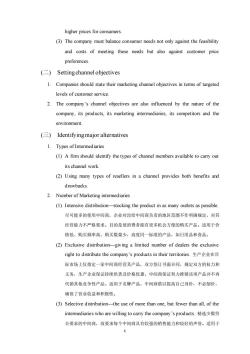
higher prices for consumers (3)The company must balance consumer needs not only against the feasibility and costs of meeting these needs but also against customer price preferences. ()Settingchannelobjectives 1.Companies should state their marketing channel objectives in terms of targeted levels of customer service. 2.The company's channel objectives are also influenced by the nature of the company,its products,its marketing intermediaries,its competitors and the environment. (Identifying major alternatives 1.Types ofIntermediaries (1)A firm should identify the types of channel members available to carry out its channel work. (2)Using many types of resellers in a channel provides both benefits and drawbacks. 2.Number of Marketing intermediaries (1)Intensive distribution-stocking the product in as many outlets as possible. 尽可能多的使用中间商,企业对没给中间商负责的地区范围不作明确规定,对其 经营能力不严格要求。目的是使消费者能有更多机会方便的购买产品。适用于价 格低、购买频率高,购买数量少,高度同一标准的产品,如日用品和食品。 (2)Exclusive distribution-giving a limited number of dealers the exclusive right to distribute the company'sproducts in their territories.生产企业在目 标市场上仅指定一家中间商经营其产品,双方签订书面合同,规定双方的权力和 义务,生产企业保证持续供货及价格优惠,中间商保证努力推销该项产品并不再 代销其他竞争性产品。适用于名牌产品,中间商借以提高自己身价,不必削价 确保了营业收益和积极性。 (3)Selective distribution-the use of more than one,but fewer than all,of the intermediaries who are willing to carry the company's products.精选少数符 合要求的中间商,故要求每个中间商具有较强的销售能力和较好的声誉。适用于 6
6 higher prices for consumers. (3) The company must balance consumer needs not only against the feasibility and costs of meeting these needs but also against customer price preferences. (二) Setting channel objectives 1. Companies should state their marketing channel objectives in terms of targeted levels of customer service. 2. The company’s channel objectives are also influenced by the nature of the company, its products, its marketing intermediaries, its competitors and the environment. (三) Identifying major alternatives 1. Types of Intermediaries (1) A firm should identify the types of channel members available to carry out its channel work. (2) Using many types of resellers in a channel provides both benefits and drawbacks. 2. Number of Marketing intermediaries (1) Intensive distribution—stocking the product in as many outlets as possible. 尽可能多的使用中间商,企业对没给中间商负责的地区范围不作明确规定,对其 经营能力不严格要求。目的是使消费者能有更多机会方便的购买产品。适用于价 格低、购买频率高,购买数量少,高度同一标准的产品,如日用品和食品。 (2) Exclusive distribution—giving a limited number of dealers the exclusive right to distribute the company’s products in their territories. 生产企业在目 标市场上仅指定一家中间商经营其产品,双方签订书面合同,规定双方的权力和 义务,生产企业保证持续供货及价格优惠,中间商保证努力推销该项产品并不再 代销其他竞争性产品。适用于名牌产品,中间商借以提高自己身价,不必削价, 确保了营业收益和积极性。 (3) Selective distribution—the use of more than one, but fewer than all, of the intermediaries who are willing to carry the company’s products. 精选少数符 合要求的中间商,故要求每个中间商具有较强的销售能力和较好的声誉。适用于
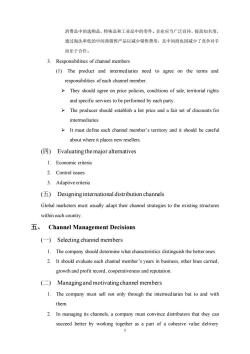
消费品中的选购品,特殊品和工业品中的零件。企业应当广泛宣传,提高知名度 通过淘汰率低的中间商销售产品以减少销售费用,且中间商也因减少了竞争对手 而乐于合作。 3.Responsibilities of channel members (1)The product and intermediaries need to agree on the terms and responsibilities of each channel member. They should agree on price policies,conditions of sale,territorial rights and specific services to be performed by each party. The producer should establish a list price and a fair set of discounts for intermediaries. >It must define each channel member's territory and it should be careful about where it places new resellers. (Evaluating the major alternatives 1.Economic criteria 2.Control issues 3.Adaptive criteria ()Designing international distribution channels Global marketers must usually adapt their channel strategies to the existing structures within each country. 五、Channel Management Decisions (-)Selecting channel members 1.The company should determine what characteristics distinguish the better ones. 2.It should evaluate each channel member's years in business,other lines carried, growth and profit record,cooperativeness and reputation. ()Managingand motivating channel members 1.The company must sell not only through the intermediaries but to and with them. 2.In managing its channels,a company must convince distributors that they can succeed better by working together as a part of a cohesive value delivery 7
7 消费品中的选购品,特殊品和工业品中的零件。企业应当广泛宣传,提高知名度, 通过淘汰率低的中间商销售产品以减少销售费用,且中间商也因减少了竞争对手 而乐于合作。 3. Responsibilities of channel members (1) The product and intermediaries need to agree on the terms and responsibilities of each channel member. ➢ They should agree on price policies, conditions of sale, territorial rights and specific services to be performed by each party. ➢ The producer should establish a list price and a fair set of discounts for intermediaries. ➢ It must define each channel member’s territory and it should be careful about where it places new resellers. (四) Evaluating the major alternatives 1. Economic criteria 2. Control issues 3. Adaptive criteria (五) Designing international distribution channels Global marketers must usually adapt their channel strategies to the existing structures within each country. 五、 Channel Management Decisions (一) Selecting channel members 1. The company should determine what characteristics distinguish the better ones. 2. It should evaluate each channel member’s years in business, other lines carried, growth and profit record, cooperativeness and reputation. (二) Managing and motivating channel members 1. The company must sell not only through the intermediaries but to and with them. 2. In managing its channels, a company must convince distributors that they can succeed better by working together as a part of a cohesive value delivery
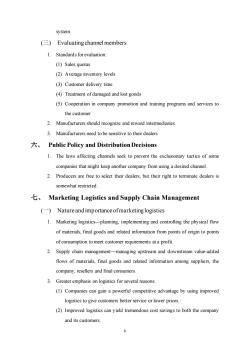
system ()Evaluatingchannel members 1.Standards for evaluation: (1)Sales quotas (2)Average inventory levels (3)Customer delivery time (4)Treatment of damaged and lost goods (5)Cooperation in company promotion and training programs and services to the customer 2.Manufacturers should recognize and reward intermediaries. 3.Manufacturers need to be sensitive to their dealers 六、Public Policy and Distribution Decisions 1.The laws affecting channels seek to prevent the exclusionary tactics of some companies that might keep another company from using a desired channel. 2.Producers are free to select their dealers,but their right to terminate dealers is somewhat restricted. Marketing Logistics and Supply Chain Management (-)Nature and importance ofmarketing logistics 1.Marketing logistics-planning.implementing and controlling the physical flow of materials,final goods and related information from points of origin to points of consumption to meet customer requirements at a profit. 2.Supply chain management-managing upstream and downstream value-added flows of materials,final goods and related information among suppliers.the company,resellers and final consumers. 3.Greater emphasis on logistics for several reasons (1)Companies can gain a powerful competitive advantage by using improved logistics to give customers better service or lower prices. (2)Improved logistics can yield tremendous cost savings to both the company and its customers
8 system. (三) Evaluating channel members 1. Standards for evaluation: (1) Sales quotas (2) Average inventory levels (3) Customer delivery time (4) Treatment of damaged and lost goods (5) Cooperation in company promotion and training programs and services to the customer 2. Manufacturers should recognize and reward intermediaries. 3. Manufacturers need to be sensitive to their dealers 六、 Public Policy and Distribution Decisions 1. The laws affecting channels seek to prevent the exclusionary tactics of some companies that might keep another company from using a desired channel. 2. Producers are free to select their dealers, but their right to terminate dealers is somewhat restricted. 七、 Marketing Logistics and Supply Chain Management (一) Nature and importance of marketing logistics 1. Marketing logistics—planning, implementing and controlling the physical flow of materials, final goods and related information from points of origin to points of consumption to meet customer requirements at a profit. 2. Supply chain management—managing upstream and downstream value-added flows of materials, final goods and related information among suppliers, the company, resellers and final consumers. 3. Greater emphasis on logistics for several reasons: (1) Companies can gain a powerful competitive advantage by using improved logistics to give customers better service or lower prices. (2) Improved logistics can yield tremendous cost savings to both the company and its customers

(3)The explosion in product variety has created a need for improved logistics management. (4)More than almost any other marketing function,logistics affects the environment and a fir's environmental sustainability efforts. ()Goals ofthe logistics system 1.The goal of marketing logistics should be to provide a targeted level of customer service at the least cost. 2.The company must weigh the benefits of providing higher levels of service against the costs. ()Major logistics functions 1.Warehousing (1)A company must decide on how many and what types of warehouses it needs and where they will be located. (2)Warehousing has seen dramatic changes in technology in recent years 2.Inventory management (1)Managers must maintain the delicate balance between carrying too little inventory and carrying too much. (2)Many companies have greatly reduced their inventories and related costs through just-in-time logistics systems. (3)Marketers are always looking for new ways to make inventory management. 3.Transportation (1)Trucks-highly flexible in routing and time schedules;offer faster service than railroads;efficient for short hauls of high-value merchand ise. (2)Railroads-most cost-effective modes for shipping large amounts of bulk products (3)Water carriers-low cost,slowest (④Pipelines (⑤)Air-fast (⑥)The Internet 9
9 (3) The explosion in product variety has created a need for improved logistics management. (4) More than almost any other marketing function, logistics affects the environment and a firm’s environmental sustainability efforts. (二) Goals of the logistics system 1. The goal of marketing logistics should be to provide a targeted level of customer service at the least cost. 2. The company must weigh the benefits of providing higher levels of service against the costs. (三) Major logistics functions 1. Warehousing (1) A company must decide on how many and what types of warehouses it needs and where they will be located. (2) Warehousing has seen dramatic changes in technology in recent years. 2. Inventory management (1) Managers must maintain the delicate balance between carrying too little inventory and carrying too much. (2) Many companies have greatly reduced their inventories and related costs through just-in-time logistics systems. (3) Marketers are always looking for new ways to make inventory management. 3. Transportation (1) Trucks—highly flexible in routing and time schedules; offer faster service than railroads; efficient for short hauls of high-value merchandise. (2) Railroads—most cost-effective modes for shipping large amounts of bulk products (3) Water carriers—low cost, slowest (4) Pipelines (5) Air—fast (6) The Internet

4.Logistics information management (Integrated logistics management 1.Cross-functional teamwork inside the company The goal of integrated supply chain management is to harmonize all of the company's logistics decisions. (1)Create permanent logistics committees made up of managers responsible for different physical distribution activities. (2)Create supply chain manager positions that link the logistics activities of functional areas. (3)Employ sophisticated,systemwide supply chain management software,now available from a wide range of software enterprises. 2.Building logistics partnerships (1)Smart companies coordinate their logistics strategies and forge strong partnerships with suppliers and customers to improve customer service and reduce channel costs (2)Other companies partner through shared projects. 3.Third-party logistics (1)Third-party logistics providers(3PL)an independent logistics provider that performs any or all of the functions required to get its client's product to market (2)Companies use 3PL for several reasons: 1)Because getting the product to market is their main focus,these providers can often do it more efficiently and at lower cost. 2)Outsourcing logistics frees a company to focus more intensely on its core business. 3)Integrated logistics companies understand increasingly complex logistics environments. (3)3PL can be especially helpful to companies attempting to expand their global market coverage 10
10 4. Logistics information management (四) Integrated logistics management 1. Cross-functional teamwork inside the company The goal of integrated supply chain management is to harmonize all of the company’s logistics decisions. (1) Create permanent logistics committees made up of managers responsible for different physical distribution activities. (2) Create supply chain manager positions that link the logistics activities of functional areas. (3) Employ sophisticated, systemwide supply chain management software, now available from a wide range of software enterprises. 2. Building logistics partnerships (1) Smart companies coordinate their logistics strategies and forge strong partnerships with suppliers and customers to improve customer service and reduce channel costs. (2) Other companies partner through shared projects. 3. Third-party logistics (1) Third-party logistics providers(3PL)—an independent logistics provider that performs any or all of the functions required to get its client’s product to market. (2) Companies use 3PL for several reasons: 1) Because getting the product to market is their main focus, these providers can often do it more efficiently and at lower cost. 2) Outsourcing logistics frees a company to focus more intensely on its core business. 3) Integrated logistics companies understand increasingly complex logistics environments. (3) 3PL can be especially helpful to companies attempting to expand their global market coverage
按次数下载不扣除下载券;
注册用户24小时内重复下载只扣除一次;
顺序:VIP每日次数-->可用次数-->下载券;
- 内蒙古科技大学:《市场营销学》课程授课教案(中文)第1章 营销与营销过程.doc
- 内蒙古科技大学:《市场营销学》课程授课教案(中文)第3章 营销系统与营销环境分析.doc
- 内蒙古科技大学:《市场营销学》课程授课教案(中文)第4章 消费者市场与购买行为分析.doc
- 内蒙古科技大学:《市场营销学》课程授课教案(中文)第2章 顾客价值与顾客满意.doc
- 内蒙古科技大学:《市场营销学》课程授课教案(中文)第9章 市场传播与促销.doc
- 内蒙古科技大学:《市场营销学》课程授课教案(中文)第10章 产品生命周期与营销战略.doc
- 内蒙古科技大学:《市场营销学》课程授课教案(中文)第6章 产品决策.doc
- 内蒙古科技大学:《市场营销学》课程授课教案(中文)第5章 市场细分、决定目标市场与定位.doc
- 内蒙古科技大学:《市场营销学》课程授课教案(中文)第7章 价格策略.doc
- 内蒙古科技大学:《市场营销学》课程授课教案(中文)第8章 分销管理.doc
- 内蒙古科技大学:《市场营销学》课程教学资源(试卷习题)2013-2014第二学期试卷A(答案).doc
- 内蒙古科技大学:《市场营销学》课程教学资源(试卷习题)2013-2014第二学期试卷A(试题).doc
- 内蒙古科技大学:《市场营销学》课程教学资源(试卷习题)2012-2013第二学期试卷B(答案).doc
- 内蒙古科技大学:《市场营销学》课程教学资源(试卷习题)2012-2013第二学期试卷B(试题).doc
- 内蒙古科技大学:《市场营销学》课程教学资源(试卷习题)2012-2013第一学期试卷A(答案).doc
- 内蒙古科技大学:《市场营销学》课程教学资源(试卷习题)2012-2013第一学期试卷B(答案).doc
- 内蒙古科技大学:《市场营销学》课程教学资源(试卷习题)2012-2013第一学期试卷B(试题).doc
- 内蒙古科技大学:《市场营销学》课程教学资源(试卷习题)2012-2013第一学期试卷A(试题).doc
- 内蒙古科技大学:《市场营销学》课程教学资源(试卷习题)2011-2012第二学期试卷A(答案).doc
- 内蒙古科技大学:《市场营销学》课程教学资源(试卷习题)2011-2012第二学期试卷B(试题).doc
- 《市场营销学》课程授课教案(双语)Chapter 9 Pricing and Pricing Strategies.doc
- 《市场营销学》课程授课教案(双语)Chapter 6 Business Markets and Business Buyer Behavior.doc
- 《市场营销学》课程授课教案(双语)Chapter 7 Customer-Driven Marketing Strategy.doc
- 《市场营销学》课程授课教案(双语)Chapter 8 Products, Services, and Brands.doc
- 《市场营销学》课程授课教案(双语)Chapter 11 Communicating Customer Value.doc
- 《市场营销学》课程授课教案(双语)Chapter 2 Company and Marketing Strategy.doc
- 《市场营销学》课程授课教案(双语)Chapter 4 Managing Marketing Information to Gain Customer Insights.doc
- 《市场营销学》课程授课教案(双语)Chapter 5 Consumer Markets and Consumer Buyer Behavior.doc
- 《市场营销学》课程授课教案(双语)Chapter 3 Analyzing the Marketing Environment.doc
- 《市场营销学》课程授课教案(双语)Chapter 1 Marketing.doc
- 《市场营销学》课程教学案例(中文)第8章案例 分销渠道策略-通用公司打造全球供应链.doc
- 《市场营销学》课程教学案例(中文)第9章案例 促销策略-中国肥皂泡戏煞东瀛人.doc
- 《市场营销学》课程教学案例(中文)第6章案例 产品决策-广东太阳神的产品组合.doc
- 《市场营销学》课程教学案例(中文)第7章案例 价格决策-海信空调的价格策略.doc
- 《市场营销学》课程教学案例(中文)第5章案例 市场细分、决定目标市场与定位- “红高粱”的启示.doc
- 《市场营销学》课程教学案例(中文)第3章案例 市场营销环境-恒伟药业信息调研出效益.doc
- 《市场营销学》课程教学案例(中文)第4章案例 分析消费者市场与购买行为-小阿华的“精确营销”.doc
- 《市场营销学》课程教学案例(中文)第2章案例 规划企业战略与市场营销管理-雅戈尔,选择没有对错.doc
- 《市场营销学》课程教学案例(中文)第1章案例 营销与营销管理-亚马逊名震全球之道.doc
- 《市场营销学》课程教学案例(双语)The Pepsi and Coca-Cola Challenge-A Cola with Breakfast.doc
